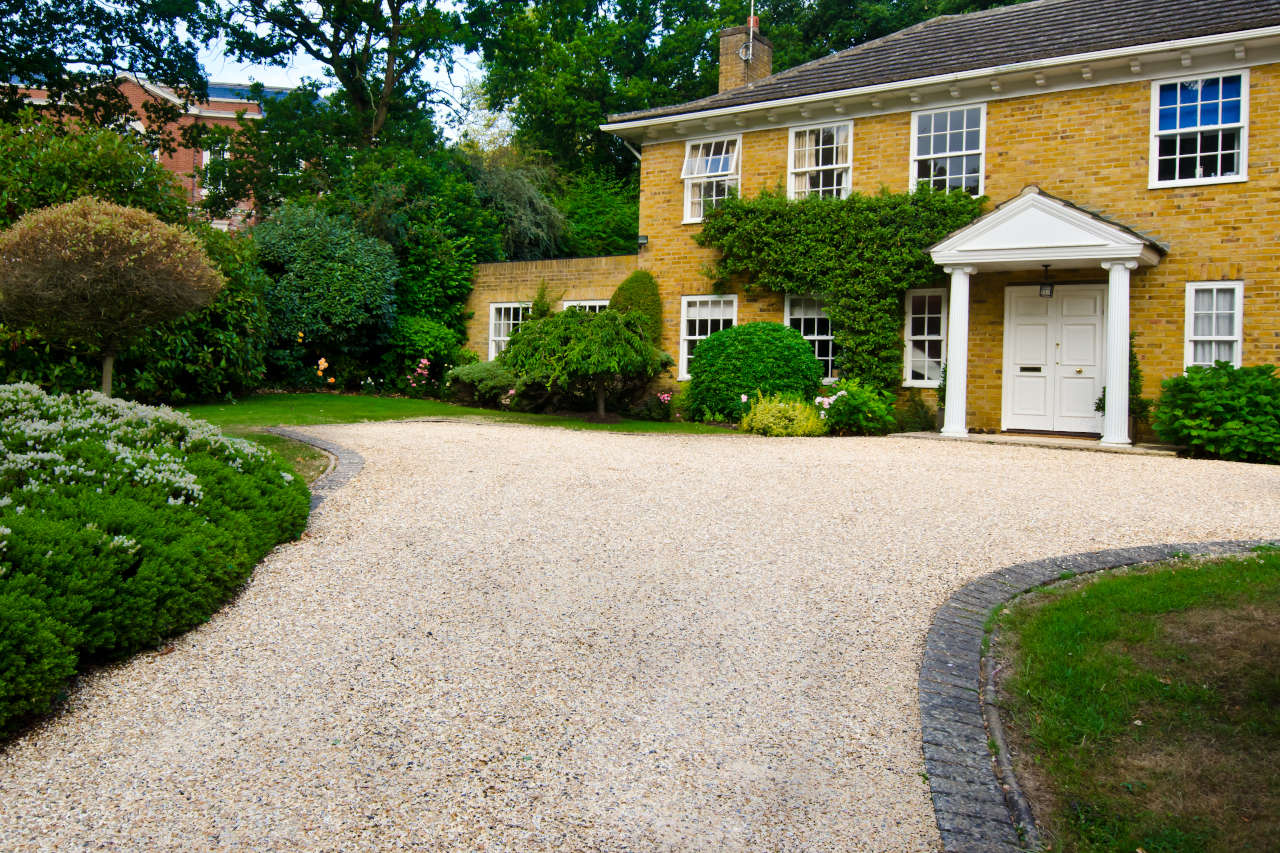Gravel Driveway Calculator
Find the amount of gravel needed for a driveway by entering the dimensions of the driveway below. Add the price per cubic yard to estimate the cost of the stone.
Crushed Stone Material Estimate:
On this page:
How to Estimate a Gravel Driveway

Crushed stone is a common material to use for a driveway because it offers a nice clean look, resists weeds, and is easy to install. Gravel driveways are also one of the most affordable types, making them a good choice for homeowners that have large driveways or who are on a budget.
Gravel does have a tendency to migrate, however, so many people with gravel driveways need to order new material every few years to keep the driveway looking its best. Gravel is commonly sold by the cubic yard, so to find the material needed for a driveway, you need to find the volume in yards.
Calculate How Many Cubic Yards of Gravel You Need
Estimating gravel driveway materials is as simple as estimating the cubic yards of volume the driveway needs to be. Cubic yards are found by multiplying the length by the width by the depth in yards.
Find the driveway’s length and width in yards by dividing the measurement in feet by 3. A 100′ measuring tape or measuring wheel may be needed to find these measurements depending on how long the driveway is.
Divide the measurement in inches by 36 to find the driveway’s depth in yards.
Most driveways should have a depth of 6″-8″ of gravel, but the entire driveway should be between 12″ to 18″ deep, made up of several different layers of material.
The top layer can be anywhere from 4″ to 8″ depending on your preferences and the type of gravel being used.
In most cases, you will have three layers of gravel: a sub-base that will be 6″ deep, a base that is 6″ deep, and a surface that is 6″ deep.
Each type of gravel will be different, with the sub-base being made of #3 gravel. This is a mixture of crushed stone up to 2″ in size.
The base layer or middle layer is usually made of #57 crushed stone. These stones are round but rough and are about the size of golf balls.
The final layer or surface layer can be made of smaller, more attractive gravel, including pea gravel, Jersey shore gravel, river rocks, or marble chips. Because this layer is finer, it is more likely to migrate and is the layer that most commonly must be replenished periodically.
The formula to find volume is length × width × depth. Multiply the width by the length by the depth in yards to find the cubic yards of gravel needed.
For example, if you are creating a driveway that is 30′ long and 12′ wide, and will use 18″ of total material, your calculations will look like this:
10 × 4 × .17 = 6.8 cu yds per layer
Round up to the nearest full yard for 7 cubic yards of each type of gravel used.
You will need to take this step for each layer if you are creating a new driveway. If you are replenishing the top layer, you will only need to do this once.
It’s a good idea to make sure that you have at least some extra gravel for each layer. Gravel can shift and you may lose some during the transfer from the truck to the driveway. By ordering roughly 10% more, you can mitigate any losses and ensure that you have enough material for the project.
Calculate How Many Tons of Gravel are Needed
Gravel is sometimes sold by the ton instead of the cubic yard. If you know how many cubic yards of gravel are needed, then find the number of tons needed by multiplying the cubic yards by 1.35.
For example, let’s calculate how much 50 cubic yards of gravel weighs using this formula.
50 cu yds × 1.35 = 67.5 tons
Note that different materials have different weights. Crushed gravel weighs about 1.35 tons per cubic yard, but other materials may vary in weight.
You can learn more about this on our gravel calculator.
Keep in mind that there are many types of crushed stone and rock that can be used on a driveway. Depending on your area and how much rain you get, you may use different base layers to facilitate drainage.
The larger the rocks used, the less volume you get per ton. Small rocks and gravel will shift together more tightly, so you can get a lot more volume per ton, and therefore have different weights.
Gravel driveways can range in price depending on their size and the type of gravel used, learn more about what impacts the cost.
Keep in mind that while most gravel driveways are more affordable than other driveways, they do require a lot more upkeep and maintenance. This includes adding additional material to the driveway periodically. The more costly your top surface layer, the more expensive your upkeep.
See our concrete driveway calculator if you want to compare to using concrete for your project.


